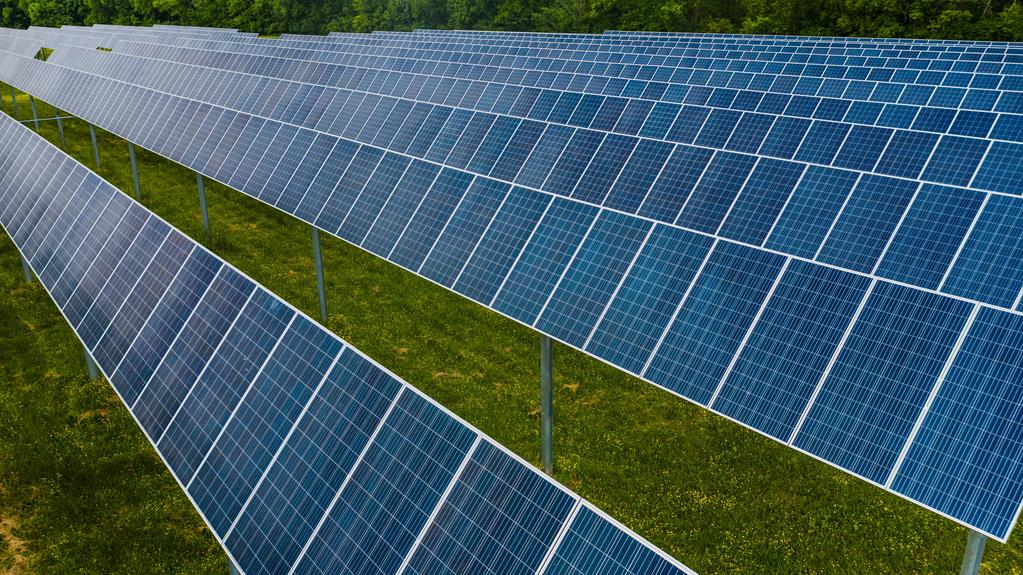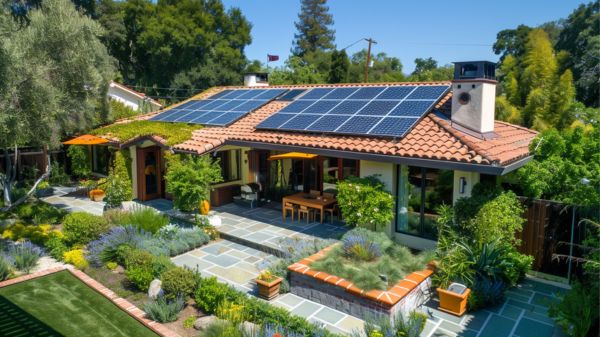Exploring the domain of solar energy for eco-friendly living presents a gateway to a sustainable lifestyle that not only benefits the environment but also offers a viable solution for reducing energy costs.
The intricate world of solar panels, installation techniques, and energy storage options can seem challenging at first glance. However, by understanding the nuances of harnessing solar power effectively, individuals can venture towards a greener tomorrow.
This guide will unravel the complexities of solar energy utilization, shedding light on the practicality and advantages of integrating solar solutions into everyday living.
Key Takeaways
- Choose monocrystalline panels for high efficiency.
- Opt for proper installation to maximize sunlight exposure.
- Consider financial savings and incentives for affordability.
- Regular maintenance ensures long-term efficiency.
- Embrace solar energy for a greener, sustainable lifestyle.
Solar Panel Types and Options
In the domain of harnessing solar energy for eco-friendly living, an important aspect to ponder is the diverse range of solar panel types and options available to consumers.
Monocrystalline solar panels stand out for their high efficiency levels, making them ideal for installations with limited space.
On the other hand, polycrystalline solar panels offer a cost-effective option, albeit with slightly lower efficiency, and are favored for residential and commercial applications.
Thin-film solar panels, although less efficient compared to crystalline panels, present a lightweight and flexible alternative suitable for curved or portable surfaces.
Bifacial solar panels, capable of capturing sunlight from both sides, excel in increasing energy production and efficiency, particularly in reflective environments.
Additionally, PERC (Passivated Emitter Rear Cell) solar panels, with a rear-side passivation layer, are renowned for enhancing energy conversion efficiency, making them a popular choice for high-performance installations.
The diverse array of solar panel types allows consumers to select the most suitable option based on their specific needs and requirements.
Solar Panel Installation Tips
Exploring the intricacies of solar panel installation reveals strategic approaches that optimize energy production and system longevity, complementing the diverse array of panel options available. Proper positioning and orientation of solar panels play an essential role in maximizing sunlight exposure for high energy production.
Ensuring the correct installation of solar panels is vital for their performance and durability over time. Regular maintenance is also key to efficient operation and long-term energy efficiency. Once installed correctly, solar panels require minimal maintenance, contributing to their overall efficiency.
Selecting the right location and adhering to installation best practices are fundamental factors in the successful operation of solar panels. By following these installation tips diligently, individuals can enhance the energy efficiency of their solar panel systems, ultimately leading to a more sustainable and environmentally friendly lifestyle.
Solar Energy Efficiency Benefits
Solar energy efficiency benefits encompass:
- A detailed analysis of cost savings
- An assessment of the environmental impact of utilizing solar panels.
Understanding the efficiency rates of different types of solar panels and the factors influencing their performance is essential for maximizing energy production.
Cost Savings Analysis
In addition to the advancement of solar panel technology, homeowners can now benefit from significant cost savings on electricity bills over the long term. When considering the cost of solar panels and the efficiency they offer, the return on investment can be substantial, often ranging between 10-20%, outperforming traditional investments.
Additionally, solar panels can save homeowners an average of $10,000 to $30,000 over 20 years on electricity bills, making them a financially wise choice. Furthermore, the reduction in carbon dioxide emissions by an average of 3-4 tons per year contributes to a greener environment, aligning with the goals of eco-friendly living.
The decreasing cost of solar panels by 70% in the past decade further solidifies solar energy as a cost-effective and sustainable option for homeowners.
Environmental Impact Assessment
Harnessing the power of solar energy for environmental impact assessment involves evaluating the key benefits of utilizing this renewable energy source to reduce carbon emissions and promote sustainable living practices. Solar panels, with an efficiency rate of around 15-22%, play an essential role in converting sunlight into electricity with minimal environmental impact.
By harnessing renewable energy sources through the photovoltaic effect, solar energy greatly reduces the carbon footprint by replacing fossil fuels with clean power alternatives. The environmental benefits of solar energy extend to reducing air pollution, minimizing water usage, and cutting greenhouse gas emissions.
Embracing solar panels not only contributes to sustainable living but also leads to long-term environmental benefits, including mitigating climate change and fostering eco-friendly practices.
Financial Savings With Solar Panels
Maximizing financial efficiency through the utilization of solar panels can result in substantial long-term savings for homeowners. Installing solar panels can lead to savings of thousands of dollars over the system’s lifetime. Homeowners can see a return on investment in as little as 5-7 years with solar panel installations.
Solar panels can reduce electricity bills by up to 70-100%, depending on the system size and energy consumption. Government incentives and rebates can further lower upfront costs, making solar panels a financially smart choice. Additionally, solar panel systems can increase property value by an average of $15,000, providing long-term financial benefits.
Environmental Impact of Solar Power
Solar power’s environmental impact is paramount, with the ability to greatly reduce carbon dioxide emissions and promote sustainability.
By harnessing solar energy, individuals and businesses can actively contribute to a cleaner, greener future.
The adoption of solar panels not only lessens reliance on non-renewable resources but also plays a vital role in mitigating the harmful effects of traditional energy sources on the environment.
Solar Power Benefits
Utilizing solar power as an alternative energy source greatly reduces carbon dioxide emissions, thereby contributing to a cleaner and more sustainable environment. Solar power offers a multitude of benefits that align with the principles of sustainable living and environmental consciousness:
- Renewable Energy: Solar panels harness the sun’s energy to produce electricity, reducing dependency on fossil fuels and lowering carbon emissions.
- Cleaner Environment: By converting sunlight into electricity, solar power helps mitigate the harmful effects of traditional energy sources, leading to cleaner air and water.
- Promoting Sustainability: Embracing solar energy not only reduces carbon footprints but also fosters a greener future for generations to come, supporting the global shift towards eco-friendly practices.
Carbon Footprint Reduction
Harnessing the power of solar energy for electricity production not only promotes sustainability but also greatly reduces carbon footprints by minimizing reliance on traditional fossil fuel-based sources. Solar panels play a pivotal role in reducing carbon emissions, offering an eco-friendly alternative to conventional power generation methods.
By adopting solar power, individuals and businesses can actively contribute to mitigating the harmful effects of carbon emissions, leading to a cleaner and healthier environment. The direct conversion of sunlight into electricity by solar panels helps in avoiding the carbon emissions associated with traditional energy production.
Embracing solar energy represents a significant step towards reducing the environmental impact of energy consumption and fostering a more sustainable future for all.
Solar Panel Maintenance Guide
Effective maintenance of solar panels is essential for optimizing energy production and ensuring long-term performance. To achieve this, follow these key steps:
- Regular Cleaning and Shading Checks: Clear debris from the panels and check for any shading issues that could affect energy production.
- Inspect Panel Connections and Wiring: Regularly examine panel connections and wiring for damage or corrosion to maintain the system’s efficiency.
- Monitor the Inverter and Error Codes: Keep an eye on the inverter to guarantee it is functioning properly. Check for any error codes that may indicate issues with the system.
Additionally, it’s vital to trim any overhanging branches or foliage that could block sunlight from reaching the solar panels. By keeping a detailed record of maintenance activities and scheduling routine inspections, you can identify and address potential problems early on, ultimately extending the lifespan of your solar panel system. Regular maintenance not only optimizes energy production but also contributes to a more sustainable and eco-friendly lifestyle.
Solar Energy Storage Solutions
Solar energy storage solutions play an essential role in maximizing the efficiency and reliability of solar power systems. When considering energy storage options for solar panels, factors such as battery lifespan, maintenance requirements, cost, and environmental impact should all be taken into account. Common choices for storing excess solar energy include lead-acid, lithium-ion, and flow batteries.
The selection of an energy storage solution should be based on specific energy needs and preferences to guarantee a continuous power supply, especially for off-grid living situations where reliance on stored energy is critical. Understanding the capacity required to meet energy needs is crucial in optimizing the performance of solar energy systems.
Solar Panel Incentives and Rebates
Various government rebate programs and tax incentives are important factors to take into account when contemplating solar panel installations. These financial benefits can lead to significant savings on energy costs over time, making solar energy a smart and sustainable investment for both residential and commercial properties.
Understanding the available incentives and rebates is vital for maximizing the return on investment and promoting eco-friendly living practices.
Government Rebate Programs
Government rebate programs play an essential role in promoting the widespread adoption of solar panels by offering financial incentives to offset installation costs. These programs can greatly reduce the upfront cost of installing a solar energy system, making it more accessible to homeowners and businesses.
Here are three key points to take into account regarding government rebate programs:
- Varied Support: Rebates may differ by state and region, providing varying levels of financial support.
- Incentive Types: Incentives can include tax credits, cash rebates, or performance-based incentives.
- Affordability: Leveraging government rebate programs can make solar energy more affordable and accessible to a broader range of individuals and organizations.
Tax Incentives Available
With the evolving landscape of tax incentives and rebates, individuals and businesses can explore a multitude of opportunities to offset the costs of solar panel installations and embrace sustainable energy solutions.
One key incentive is the Federal Investment Tax Credit (ITC), providing a 26% tax credit for solar systems installed in 2022. States may offer additional solar incentives such as rebates, property tax exemptions, and sales tax exemptions to further reduce installation costs.
It’s important to mention that the Federal Solar Tax Credit will decrease to 22% in 2023 and 10% for commercial installations post-2023. Furthermore, some states offer Solar Renewable Energy Certificates (SRECs) or performance-based incentives based on solar energy production.
Leveraging these incentives can significantly lower upfront costs and enhance returns on investment.
| Tax Incentives | Description |
|---|---|
| Federal Investment Tax Credit (ITC) | Offers a 26% tax credit for solar systems installed in 2022. |
| Solar Incentives | Additional state-specific incentives like rebates, property tax exemptions, and sales tax exemptions. |
| Property Tax Exemptions | Some states provide exemptions on property taxes for properties with solar panel installations. |
| Solar Renewable Energy Certificates (SRECs) | States offer SRECs as incentives for solar energy production, enhancing the economic benefits. |
Savings on Energy
Efficiently harnessing solar panel incentives and rebates can greatly reduce the initial financial burden associated with moving to solar energy systems for both residential and commercial properties. Here are some key points to keep in mind:
- Financial Incentives: Various states and local governments offer financial incentives, tax credits, and rebates, such as the Federal Investment Tax Credit (ITC), covering up to 26% of the total system cost.
- Utility Rebates: Utility companies provide rebates that further decrease the overall cost of installing solar panels, ensuring long-term savings on energy bills.
- Smart Investment: Leveraging these incentives and rebates transforms shifting to solar power into a financially prudent decision, offering a sustainable and cost-effective energy solution for homeowners and businesses alike.
Solar Panel Technology Advancements
Advancing solar panel technology has revolutionized the efficiency and performance levels of renewable energy systems. With continuous innovations, solar panels have greatly increased their efficiency, leading to improved energy production.
The introduction of bifacial solar panels marks a milestone, allowing for the capture of sunlight from both sides, thereby enhancing energy output. Additionally, the ongoing research on perovskite solar cells shows great potential for achieving even higher efficiency levels while reducing production costs, making solar energy more accessible and cost-effective.
In addition, the integration of smart technology into solar panels enables better monitoring and optimization of energy generation, maximizing the benefits of solar power systems. These advancements in solar panel technology not only contribute to a greener environment but also offer a more sustainable and efficient solution for meeting energy needs.
Embracing these technologies can lead to a more eco-friendly and liberated way of living.
Solar Panel ROI and Payback Period
The advancements in solar panel technology have not only enhanced energy production and efficiency but also paved the way for a thorough examination of the Solar Panel ROI and Payback Period, crucial aspects in determining the financial viability of solar energy systems. When considering the financial implications of solar panel installation, several key factors come into play:
- ROI Potential: The return on investment (ROI) for solar panels typically ranges from 10-20% annually, making them a lucrative long-term investment for homeowners looking to reduce energy costs and environmental impact.
- Payback Period: The average payback period for solar panels is around 5-8 years, during which the savings accrued from reduced energy bills gradually offset the initial installation costs.
- Government Incentives: Government incentives and rebates can significantly shorten the payback period for solar panels, providing additional financial benefits for those looking to adopt renewable energy solutions. These incentives help make solar energy more accessible and affordable for a wider range of consumers, further enhancing the appeal of solar panel installations.
Frequently Asked Questions
How Does IRS Verify Solar Credit?
The IRS verifies solar credits through a rigorous process that includes reviewing Form 5695 for Residential Energy Credits, requesting documentation like receipts and manufacturer certifications, and confirming the eligibility of solar equipment and installation dates for tax benefits.
How We Can Use Solar Energy for Sustainable Living?
Solar panels harness sunlight to generate renewable energy, promoting sustainable living through energy efficiency. They embody green technology, offering a path towards a cleaner environment and reduced carbon footprint. Embracing solar power fosters a shift towards sustainable practices.
How Can We Make Solar Energy More Environmentally Friendly?
To enhance the environmental friendliness of solar energy, focus on solar panel recycling for reduced waste, implement energy storage solutions to minimize reliance on non-renewable sources, integrate green technology for efficiency, decrease carbon footprint, and harness renewable resources effectively.
What Is the Best Way to Harness Solar Energy?
Maximizing solar panel efficiency through strategic placement, utilizing advanced inverter technology for best energy conversion, coupling with efficient battery storage solutions, and leveraging net metering benefits are key to harnessing solar energy effectively for sustainable and eco-friendly living.
Conclusion
To sum up, utilizing solar energy for eco-friendly living offers a multitude of benefits including cost savings, reduced carbon footprint, and a cleaner environment.
By choosing the right solar panel type, ensuring proper installation, and exploring energy storage options, homeowners can make a significant impact on their energy consumption and contribute to a more sustainable future.
With advancements in technology and available incentives, shifting to solar power is a wise and financially advantageous choice for a greener tomorrow.




